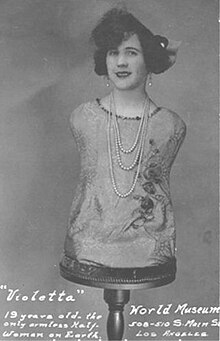| Violetta | |
|---|---|
 Violetta in 1925 Violetta in 1925 | |
| Born | Aloisia Wagner 1905 or 1906 Hemelingen, German Empire |
| Died | c.1940 (aged c. 35) |
| Known for | having tetra-amelia syndrome, sideshow performer |
| Height | c. 3 ft |
Aloisia Wagner (1905 or 1906 - c. 1940), better known by her stage name Violetta, was a German-American woman who was born without legs or arms with a condition known as tetra-amelia syndrome. She was born in Hemelingen, Germany, and had a lengthy career in sideshow performance.
Aloisia Wagner was born in either 1905 or 1906. Her exact date of birth is unknown.
On March 23, 1924, she left her birth city of Bremen-Hemelingen, Germany, with her stepbrother and manager, Karl Grobecker, aboard the SS George Washington, which arrived in New York on April 3, 1924. According to the ship manifest, Aloisia had blonde hair and green eyes, was 3 feet tall, and was allowed into the U.S. for 25 weeks to work for Samuel W. Gumpertz in his Dreamland Circus Side Show. She was the daughter of Elise Wagner, of Hemelingen, Moltkestr. 26 (map). The manifest's "Held For Special Inquiry" page shows that both were held (in the hospital) for one day before being allowed to enter the U.S. Other pages of the manifest from this ship list many members of the John Robinson Circus, which was later acquired by John Ringling, Violetta's later employer.
For many years, Aloisia performed in several sideshows and freak shows as a singer and oddity, including Coney Island's Dreamland, the Ringling Bros. and Barnum & Bailey Circus, and the Mighty Haag Circus. A 1925 photo shows her performing at the World Museum (freak show) in Los Angeles. According to his biography, Jean Cocteau visited Violetta at Luna Park, Paris in 1927, describing her as "a stubborn German woman." In 1929, the Belgian surrealist journal Variétés published a photo of Violetta.
Wallace Stort of the London Life Magazine [de] wrote about her several times. Stort's 1940 article is the last known publication referencing Violetta, describing in detail how she moved herself by hopping from place to place on the bottom of her torso and was able to manipulate objects with her mouth enough to comb her own hair, dress herself, thread a needle, and sew. Stort also stated that Violetta was married and wore her wedding band on a gold chain around her neck, though no other information about her husband is known.
See also
- Prince Randian, American limbless sideshow performer, who appeared in film Freaks in 1932.
- Nick Vujicic, a Christian evangelist and motivational speaker
- Hirotada Ototake, a sports writer.
References
- Marc Hartzman (2005). American sideshow: an encyclopedia of history's most wondrous. p. 225.
Having not a single arm, leg, or stump, Violetta was known as the Trunk Woman and the Human Torso. She was born Aloisia Wagner in Germany in 1907, and came to America in April 1924 to exhibit herself at Coney Island Dreamland.
- List or Manifest of Alien Passengers for the United States Immigration Officer at Port of Arrival, SS George Washington Passengers Sailing from Bremen, March 23, 1924, Arriving at Port of New York, April 3, 1924, 1924
- Liberty Ellis Foundation ship manifest, pp. 1–2, archived from the original on May 13, 2019
- "Violetta (performer)" (Map). Google Maps. Retrieved 5 February 2017.
- "PastPerfect". circusworld.catalogaccess.com.
- Claude Arnaud (September 27, 2016). Jean Cocteau: A Life. Yale University Press. p. 457. ISBN 978-0-300-18216-3.
- Wallace Stort (September 1926). "Famous Though Limbless". London Life Magazine. Archived from the original on February 5, 2010.
- Wallace Stort (February 1929). "Limbless People I Have Met". London Life Magazine. Archived from the original on October 15, 2009.
- ^ Wallace Stort (January 27, 1940). "Amazing Account Of A Limbless Beauty Show". London Life Magazine. Archived from the original on June 14, 2009.
External links
[REDACTED] Media related to Violetta at Wikimedia Commons
Categories: